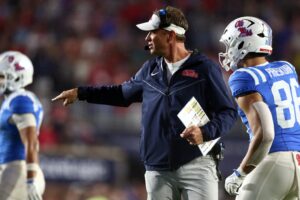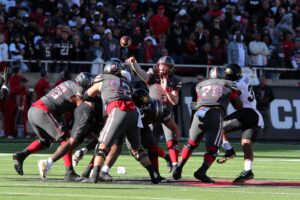It was not long ago when Spencer Petras rolled out to his right and threw across the field to a wide-open Nico Ragaini for a 43-yard, go-ahead score to beat fourth-ranked Penn State. That early-October win now feels like ages ago. The Hawkeye offense has since struggled to generate points. The remainder of Iowa’s Big Ten West schedule was viewed as a manageable road. We have seen now that this schedule is anything but manageable, and the Hawkeyes are now in search of answers.
Inept Scoring Efficiency
One of the areas of concern for Iowa this year has been the offense’s ability to move the ball down the field. In the first six games, the defense and special teams were able to provide great field position. At times, Iowa’s defense was its best offense, putting the Hawkeyes in advantageous parts of the field. There were questions about how Iowa’s offense would respond when its defense didn’t provide that cushion. Those questions came to the forefront in the last two games against Purdue and Wisconsin. The Hawkeye defense did not come up with the forced turnovers that were at one point thought of as nearly a guarantee. When Iowa’s offense needed to string together big drives consistently, it could not.
In non-defensive scoring plays this season, Iowa has taken advantage of exceptional field position. Through eight games, the average starting field position for the Hawkeye offense has been their own 48-yard line. Their lone touchdown against Wisconsin began at their opponent’s 40-yard line. In Iowa’s win against Penn State, the average scoring drive start was mid-field. Given a good starting field position, Iowa has been able to capitalize. However, their success rate when beginning a drive inside their own 25-yard line has been inadequate.
This year, Iowa has started on or inside the 25-yard line on 37 possessions. The Hawkeyes have capitalized with points on just six of those possessions. That’s a 16% success rate when starting inside the 25-yard line. Three of the six came against Group of Five opponents, meaning that just three times has Iowa been able to drive the length of the field and score against Big Ten opponents. The field position game is a big part of Iowa football, and punting is used as an offensive weapon. Questions arose regarding the sustainability of that kind of attack in today’s game, and over the last few weeks, it’s been exposed. If Iowa cannot force the necessary turnovers on defense, Petras and the offense have struggled to produce sustained drives.
Offensive Adjustments
The fix to this problem begins during the week with a change in offensive game plan. The change does not need to overhaul the entire offense, but be enough to provide variety. Iowa has had great success in getting the ball to its receivers on short throws. The offensive line ranks 111th in the nation in pass-blocking efficiency, with just a 46.3 rating according to Pro Football Focus. Petras does not have time to drop back and find receivers on deep routes. Going over the top is likely not an option for the Hawkeyes at this point, but there are answers underneath.
True freshman Keagan Johnson caught two passes against Wisconsin with 11 yards after the catch. His yards after catch per reception remain in the double-digits. He hauled in his first “contested-catch” of the season against a good Wisconsin defense. The young wide-out continues to show promise for the Hawkeye offense, but he has just 16 total targets on the year. His average depth of target is over 11 yards this season, meaning his routes have generally been longer-developing than screen passes or slants. Without time in the pocket, it doesn’t matter how open he can get downfield. To mitigate the potential of taking sacks, developing an offensive game plan with options to hit short routes to playmakers like Johnson could provide the spark Iowa needs to get the offense back on track.
Hawkeyes In Search of Answers
The Hawkeye offense exploded against the Maryland Terrapins in early October, winning 51-14 on the road. It seemed as though Iowa was able to develop an offensive look that put the Terps’ defense on their heels all game. In the last two games, however, Iowa has been outscored 51-14. The offense has looked stagnant, and the defense has not produced the turnovers they are accustomed to forcing. The chase for the Big Ten West is now out of their hands, and the Hawkeyes need to focus on rebuilding a productive offense. It begins with implementing a short passing game so the playmakers can make plays. There can still be 10 wins on this schedule, but an adjustment needs to take place before Iowa heads to Evanston next week.






